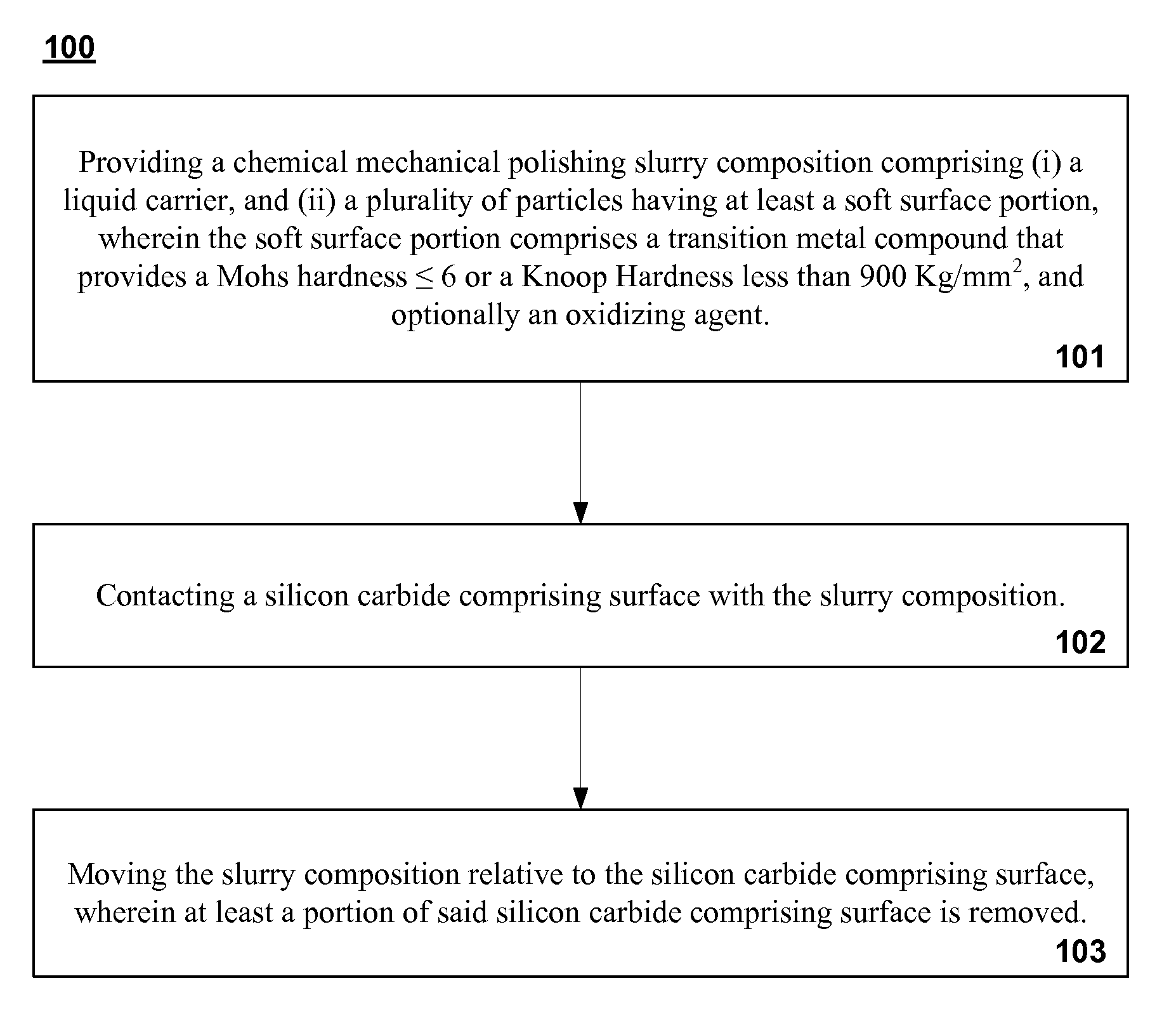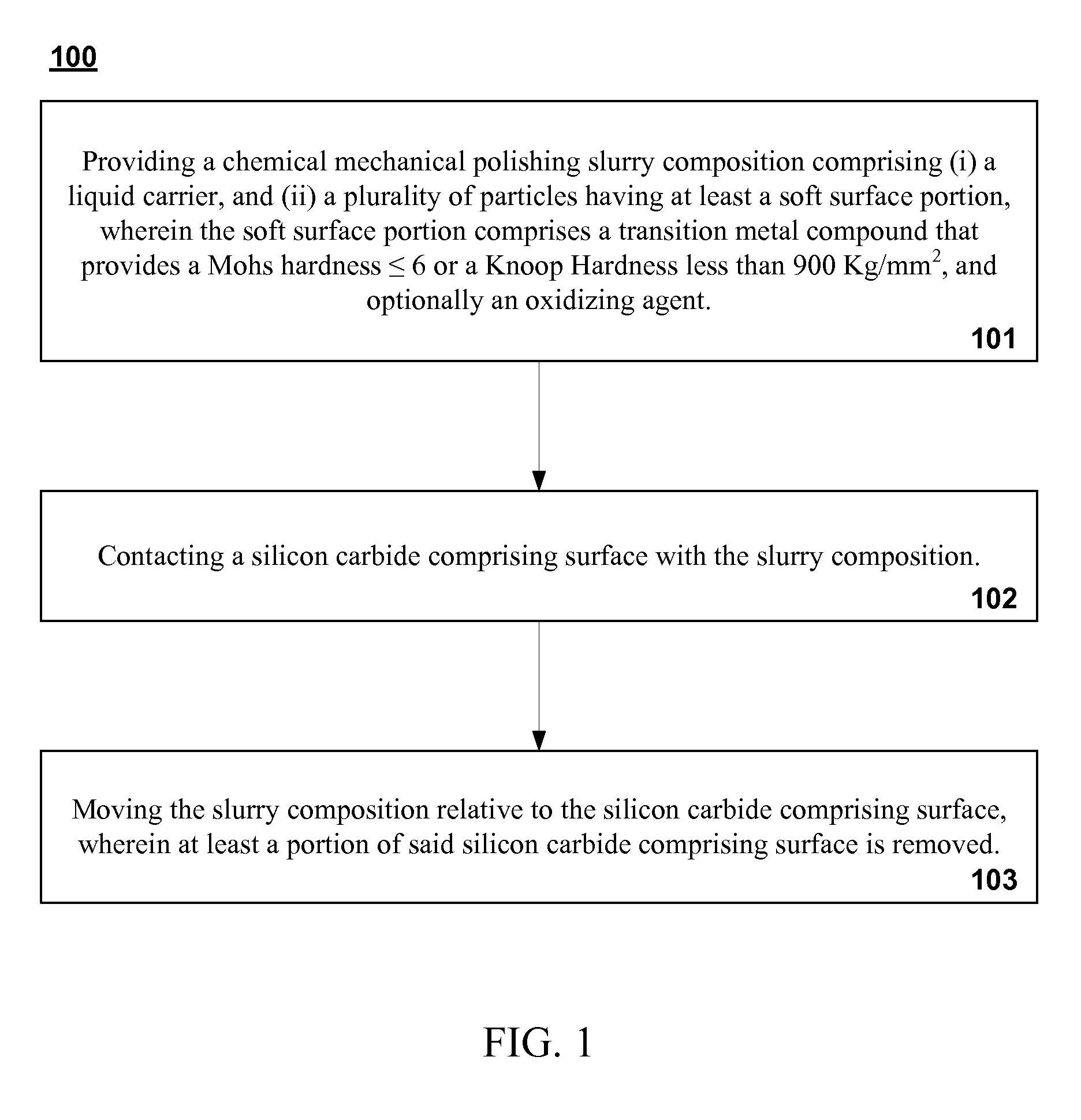Chemical mechanical polishing of silicon carbide comprising surfaces
a technology of mechanical polishing and silicon carbide, which is applied in the direction of other chemical processes, manufacturing tools, chemistry apparatus and processes, etc., can solve the problems of significant scratches and dislocations, and high degree of damage to the silicon carbide surface, so as to reduce surface and sub-surface damage, increase the polishing rate, and high polishing rate
- Summary
- Abstract
- Description
- Claims
- Application Information
AI Technical Summary
Benefits of technology
Problems solved by technology
Method used
Image
Examples
example 1
Slurry with In-Situ Formed Soft Particles
[0038]Soft particles comprising MnCl3 and manganese oxide MnO2 were prepared by adding 0.023M MnCl2 (which is water soluble) to a 0.015 KMnO4 solution. Insoluble manganese compounds MnCl3 (an example of Mn(III) state compound) and MnO2 (an example of Mn(IV) compound) were formed upon the addition of MnCl2. Once the particles were made, a stoichiometric excess of KMnO4 was added in the slurry solution remaining to function as an oxidizer. The insoluble manganese compounds each had a Mohs hardness estimated as 500 nm / hr.
pHConcentration KMnO4 (M)Removal Rate nm / hr20.4140040.412906.50.45609.00.43604.00.13603.00.02100
example 2
Slurry with Soft Surfaced Composite Particles, No Oxidizer
[0039]The soft surface comprised MnCl3 and MnO2 as described above in Example 1. The polishing using such coated particles were compared to polishing using uncoated silica particles. A significant increase in removal rate is demonstrated even in absence of the oxidizer.
pHParticle CoatingCore Particlepart Conc (wt %)RR (nm / hr)4.5Mn (III) / Mn (IV)135 nm silica10%846.5Mn (III) / Mn (IV)135 nm silica10%1096.5none135 nm silica10%1 to 52Mn (III) / Mn (IV)135 nm silica2.8% 1192Mn (III) / Mn (IV)alumina2.8% 162.5
[0040]This example evidences a highly unexpected result, namely, a significantly higher removal rate with the particles having the soft coating (Mohs hardness around 3) as compared to the removal rate with uncoated abrasive core particle (Mohs hardness around 7 for silica, higher for alumina).
example 3
Slurry with Soft Surfaced Composite Particles with Oxidizer Added
[0041]The soft surface comprised MnCl3 and MnO2 on various core particles described above in example 1. KMnO4 was added as an oxidizer. The oxidizer concentration was 0.35 M
pHCore ParticleRR (nm / hr)3Silica 135 nm13503Alumina 800 nm18003Diamond 0.2 micron23003Alumina 300 nm1700
Comparing example 1 to example 3, the addition of the KMnO4 is seen to increase the RR about an order of magnitude.
PUM
| Property | Measurement | Unit |
|---|---|---|
| Knoop hardness | aaaaa | aaaaa |
| Knoop hardness | aaaaa | aaaaa |
| Knoop hardness | aaaaa | aaaaa |
Abstract
Description
Claims
Application Information
 Login to View More
Login to View More - R&D
- Intellectual Property
- Life Sciences
- Materials
- Tech Scout
- Unparalleled Data Quality
- Higher Quality Content
- 60% Fewer Hallucinations
Browse by: Latest US Patents, China's latest patents, Technical Efficacy Thesaurus, Application Domain, Technology Topic, Popular Technical Reports.
© 2025 PatSnap. All rights reserved.Legal|Privacy policy|Modern Slavery Act Transparency Statement|Sitemap|About US| Contact US: help@patsnap.com


